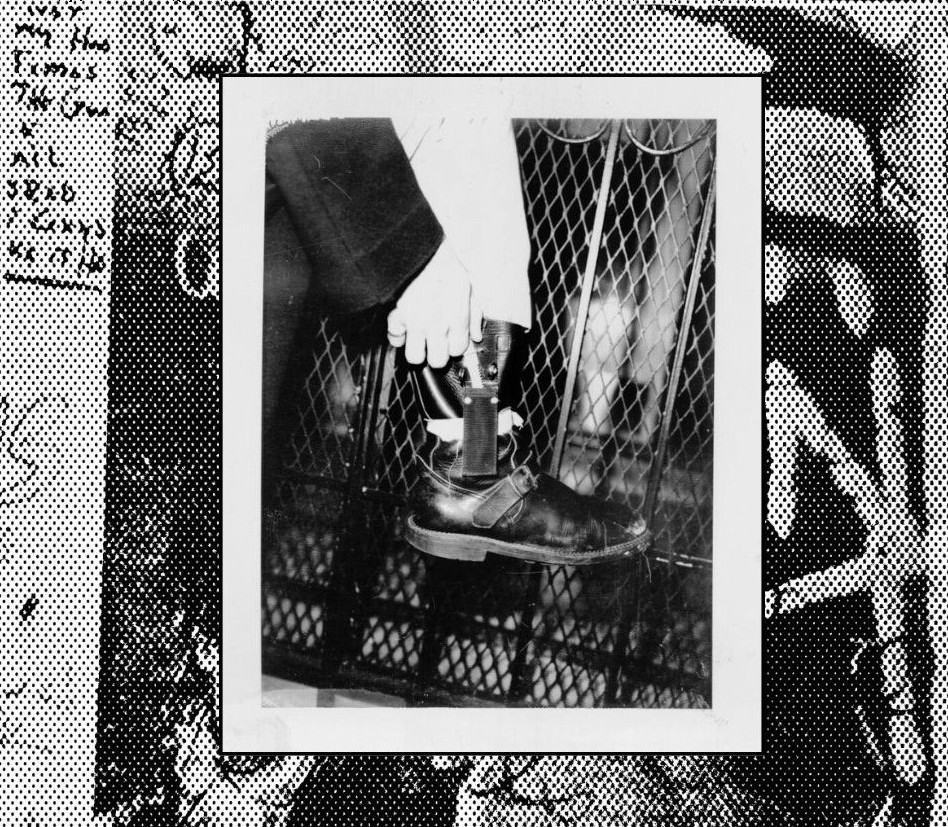 Of the many fondly remembered projects that made up the legendary LA harsh scene in the early to mid-aughts, Moth Drakula was one of the most prolific, putting out close to 30 splits, tapes, CDs, and even a 2xLP on iconic labels Callow God, Troniks, and Chondritic as well as Evan Pacewicz’s own small-batch imprint Swampland. Much like the rest, their fire fizzled around 2006, but after nearly two decades they revealed themselves to be not dead, but simply dormant. For whatever reason—the doldrums of the pandemic, perhaps, or the general feeling of a renewed interest in US noise, which may or may not be the same phenomenon—both members have resumed activity in a big way. Pacewicz helped put together a retrospective Roman Torment 2xCD for Phage and has revitalized Swampland, releasing printed matter as well as new solo work, while Josh Stewart, formerly of Genius Females and Bedrooms, is back at it as Ex Jesus. And, of course, together they’re breathing new life into Moth Drakula, which brings us here to Metal Arcade. Though just a brief 20-minute CD-R, it’s the first comeback material that jumps out as just as good, if not better than their original run. MD always had a sloppier, sleazier sound than their contemporaries, and that’s still the case here: the two pedal-slingers prioritize crudely sandwiched effects and brute-force impact over fidelity and precision (the production, muddy in the best way, helps too). Distortion-drenched samples build tension that is subsequently ripped apart by swipes and slashes. Warm melodic extracts bookend “Mirror Rejection,” the midst of which is overrun by writhing feedback screeches; the white-hot abrasions of “Shut Out and Crushed” drop into a loose-slung hypnosis loop. If you were waiting on an excuse to put in a Swampland order, this is it (plus the Roman Torment discog comp is only $10).
Of the many fondly remembered projects that made up the legendary LA harsh scene in the early to mid-aughts, Moth Drakula was one of the most prolific, putting out close to 30 splits, tapes, CDs, and even a 2xLP on iconic labels Callow God, Troniks, and Chondritic as well as Evan Pacewicz’s own small-batch imprint Swampland. Much like the rest, their fire fizzled around 2006, but after nearly two decades they revealed themselves to be not dead, but simply dormant. For whatever reason—the doldrums of the pandemic, perhaps, or the general feeling of a renewed interest in US noise, which may or may not be the same phenomenon—both members have resumed activity in a big way. Pacewicz helped put together a retrospective Roman Torment 2xCD for Phage and has revitalized Swampland, releasing printed matter as well as new solo work, while Josh Stewart, formerly of Genius Females and Bedrooms, is back at it as Ex Jesus. And, of course, together they’re breathing new life into Moth Drakula, which brings us here to Metal Arcade. Though just a brief 20-minute CD-R, it’s the first comeback material that jumps out as just as good, if not better than their original run. MD always had a sloppier, sleazier sound than their contemporaries, and that’s still the case here: the two pedal-slingers prioritize crudely sandwiched effects and brute-force impact over fidelity and precision (the production, muddy in the best way, helps too). Distortion-drenched samples build tension that is subsequently ripped apart by swipes and slashes. Warm melodic extracts bookend “Mirror Rejection,” the midst of which is overrun by writhing feedback screeches; the white-hot abrasions of “Shut Out and Crushed” drop into a loose-slung hypnosis loop. If you were waiting on an excuse to put in a Swampland order, this is it (plus the Roman Torment discog comp is only $10).
Review: Erell Latimier – Stay Still (Kythibong, Nov 18)
 Following 2019’s L’impatience directe des corps CD on Glistening Examples, Stay Still is the newest release from French poet and sound artist Erell Latimier. The LP comprises two extended pieces commissioned and composed within the last few years that continue her exploration of the web of connections between voice and sound. She’s far from the first to embark on this voyage—see last month’s review of Victual Vittle Bottle Cunt—but both “Ils seront silencieux après” and the title track display a more focused and singular trajectory than her previous work. The former is a spellbinding drama of both text and texture, making use of jarring junctures between lulling concrète vignettes and unaccompanied speech to imbue the narrative with a haunting dislocation. The spoken delivery of the tale of a profoundly removed woman (many thanks to the artist herself for providing a translation so I could follow along with the French) is at once forlorn and detached, as if the speaker is grasping onto these memories one last time before letting them go forever. It turns out that this process is audible too: the sentences begin to echo, then fracture as they’re laden with distortion and tape slur, before finally dissolving into a fraught harmonic coda. Latimier spotlights the spaces where distinctions are difficult. “Ils seront” ends with a dry bubbling noise that could be the rattling of undecided vocal cords, while “Stay Still” enlists a cast of guest speakers—Camille Belhoradsky, Eric Cordier, and Will Guthrie—to stitch a rotting lattice of half-formed phrases and abandoned thoughts. The artist’s own words are once again the unifying element, here doomed to be vivisected into jagged glitches. There’s a moment around the 13-minute mark, so fleeting you’ll miss it if you’re not listening closely, when a rare wail of raw emotion cuts through the murk and is immediately, mercilessly silenced. How horrific it is to break… or rather, to be broken, because there is indeed someone else here: “They noticed it and came to watch us. They stocked us in a large room and kept telling us: don’t move, don’t move—and after, louder, stay still.”
Following 2019’s L’impatience directe des corps CD on Glistening Examples, Stay Still is the newest release from French poet and sound artist Erell Latimier. The LP comprises two extended pieces commissioned and composed within the last few years that continue her exploration of the web of connections between voice and sound. She’s far from the first to embark on this voyage—see last month’s review of Victual Vittle Bottle Cunt—but both “Ils seront silencieux après” and the title track display a more focused and singular trajectory than her previous work. The former is a spellbinding drama of both text and texture, making use of jarring junctures between lulling concrète vignettes and unaccompanied speech to imbue the narrative with a haunting dislocation. The spoken delivery of the tale of a profoundly removed woman (many thanks to the artist herself for providing a translation so I could follow along with the French) is at once forlorn and detached, as if the speaker is grasping onto these memories one last time before letting them go forever. It turns out that this process is audible too: the sentences begin to echo, then fracture as they’re laden with distortion and tape slur, before finally dissolving into a fraught harmonic coda. Latimier spotlights the spaces where distinctions are difficult. “Ils seront” ends with a dry bubbling noise that could be the rattling of undecided vocal cords, while “Stay Still” enlists a cast of guest speakers—Camille Belhoradsky, Eric Cordier, and Will Guthrie—to stitch a rotting lattice of half-formed phrases and abandoned thoughts. The artist’s own words are once again the unifying element, here doomed to be vivisected into jagged glitches. There’s a moment around the 13-minute mark, so fleeting you’ll miss it if you’re not listening closely, when a rare wail of raw emotion cuts through the murk and is immediately, mercilessly silenced. How horrific it is to break… or rather, to be broken, because there is indeed someone else here: “They noticed it and came to watch us. They stocked us in a large room and kept telling us: don’t move, don’t move—and after, louder, stay still.”
Review: Ineffable Slime – Deep and Desperate Fictions (Virtues, Nov 4)
 If you weren’t already aware that Albuquerque’s Ryan O’Connor, the man behind Ineffable Slime, is an avid reader and devoted independent bookseller (dig Alarum), you could probably surmise as much from the numerous literary allusions and arcane homages scattered throughout his modest but steadily metastasizing discography. Through recent releases on Fusty and Tribe he’s homed in on a distinct aesthetic steeped in European/Anglospheric avant-garde and esotericism, sharpened to a fine point with his two full-length CDs on the Milwaukee-based Virtues label (run by Alex Kmet of Climax Denial and Sexkrime fame), Stalking the Sphinx and now Deep and Desperate Fictions. The inscriptions and imagery run right off the yellowed pages of a dusty tome, and yet O’Connor’s sound is more sterile than ever. Had I not seen him play before I might assume a heavily modular rig, or maybe even some laptop, but listening closer it’s clear it’s all about the pedals—despite the crystal-clear surgical sound, the noise is too brash and beefy, its kinesis and dynamics too gestural. It’s less contrast, more amalgam due to the eclectic setup: the samples deploy via microcassettes and tape loops add agility, all while synth boxes and glitch delays work up caustic storms. Conceptually too it feels like a more serious outing than previous ones, which featured track titles such as “Quantum Suicide of the Satanic Guido” and “Liturgical Dunce Conniption”; here, ominous phrases like “Cartesian Errata” and “Casting Leaden Eternity” evoke a cold, clinical pessimism fitting for these deep and desperate times.
If you weren’t already aware that Albuquerque’s Ryan O’Connor, the man behind Ineffable Slime, is an avid reader and devoted independent bookseller (dig Alarum), you could probably surmise as much from the numerous literary allusions and arcane homages scattered throughout his modest but steadily metastasizing discography. Through recent releases on Fusty and Tribe he’s homed in on a distinct aesthetic steeped in European/Anglospheric avant-garde and esotericism, sharpened to a fine point with his two full-length CDs on the Milwaukee-based Virtues label (run by Alex Kmet of Climax Denial and Sexkrime fame), Stalking the Sphinx and now Deep and Desperate Fictions. The inscriptions and imagery run right off the yellowed pages of a dusty tome, and yet O’Connor’s sound is more sterile than ever. Had I not seen him play before I might assume a heavily modular rig, or maybe even some laptop, but listening closer it’s clear it’s all about the pedals—despite the crystal-clear surgical sound, the noise is too brash and beefy, its kinesis and dynamics too gestural. It’s less contrast, more amalgam due to the eclectic setup: the samples deploy via microcassettes and tape loops add agility, all while synth boxes and glitch delays work up caustic storms. Conceptually too it feels like a more serious outing than previous ones, which featured track titles such as “Quantum Suicide of the Satanic Guido” and “Liturgical Dunce Conniption”; here, ominous phrases like “Cartesian Errata” and “Casting Leaden Eternity” evoke a cold, clinical pessimism fitting for these deep and desperate times.
Review: Iris Our – Victual Vittle Bottle Cunt (Recital, Oct 31)
Kiera Mulhern and Sydney Spann’s set at the Stone Circle back in March still stands as one of my favorites of the year. Prior to that, I’d seen both artists perform individually, Mulhern in an installment of Tone Glow’s Quarantine Concerts in 2021 and Spann for the opening of her Cow, Cow, Cow, Rabbit, Recalcitrance, Bunny, Dog, Dog, Dog installation at the Center for Performance Research in 2022. Unsurprisingly, their live collaboration was a direct extension of their respective bodies of work, but it also introduced a more grounded dimension. Imperfect instantaneity; the pushing of pedals; the messy, mercurial forms of base utterance. Their duo project is now known as Iris Our and has issued a lovely recorded debut with Victual Vittle Bottle Cunt, which delves deeper into that earthy realm. Structured, as always, around voice, the short five-track suite roams complex caverns, brushing by patches of “raw pink flesh.” The sense of organic space and blurred ontological boundaries are reminiscent of Mulhern’s marvelous De ossibus 20, but where that record was introspective, Victual is universal, the free-associative conduit between the two poets swelling ever outward. Ensconced in echoing piano and murky electronics, their exchange in “The Columns of Echo’s Lymphatic Library” is a thematic invocation for the CD’s focus on “femininity understood through diffusion”: “the mouth of it / wound / wound / mouth / splits open / wound / mother” (I’m paraphrasing; many of the words are spoken simultaneously). Even with the lush sound-collage instrumentals, much of Victual boils down to just great poetry. “Debris Promise” traces rent threads via rhyme—”torn sheet, or something shorn”—while “Splits and Wants” favors textural over literal meaning with its wordless birdsong chorus. In “Erections of Angels Directed at Me,” their singing (and flute-playing) is defiant light in droning mechanical darkness. Iris Our stand in a rich continuum of subversive feminine poetics encompassing everything from Tender Buttons to Dictee, Katalin Ladik to Asha Sheshadri. Abstract as it is, Victual splits the vortex of horror with a fleeting yet concrete mantra: “weather / together.”
Copies are available from Recital and various distros: Forced Exposure, All Night Flight, Soundohm, etc.
Review: Hamid Drake & Pat Thomas – A Mountain Sees a Mountain (Old Heaven Books, Oct 20)
 Having not heard of the OCT-Loft Jazz Festival held annually in the Nanshan district of Shenzhen, I assumed the “Loft Jazz Series” label on the cover of A Mountain Sees a Mountain was a reference to the 70s New York loft scene. This assumption quickly fell apart, of course; I remembered that percussionist Hamid Drake, though based in the city, only began performing a decade after rising rents and institutionalization brought that boom to an end, and that pianist Pat Thomas is English. While the series name may or may not be an homage, OCT-Loft references the area surrounding the OCT metro station, where the two free music heavyweights played as a duo for the first time in 2019. Six years later (to the day), their extended live session sees new life as a multi-format release on the record label arm of Old Heaven, the bookstore that curates the festival and serves as the venue for its performances. Drake and Thomas have met before in larger ensembles (twice on record, both at OTO via various configurations of Thomas’s Black Top project with Orphy Robinson) and their chemistry sits in a sweet spot between established rapport and boundless possibility. Thomas fires off a flurry of muscular dissonance to match Drake’s thumping intro to “The Spider’s Web,” but then they drop into a slow textural build that morphs into a lurching swing. Thomas deals in both convention and abstraction interchangeably: there are several electric moments when he’s banging out thick erratic five-finger clash chords or dizzying atonal right-hand runs, and then suddenly a surging groove appears as if out of nowhere. Drake’s hits and rolls are as raw and painterly as ever, but his singing doesn’t work as well here as it has elsewhere. “Friday the 13th,” the first of two brief encores, is a fleeting but thrilling climax that offers a glimpse of the raucous glory the duo could have worked up if they’d wanted to, but their restraint makes it all the more satisfying. Though the circumstances that led to this lovely hour of music may not be directly connected to the historic loft era, its eternal spirit is alive and well—this is the sound of community, of two artists separated by one ocean crossing yet another to meet an eager audience. As Drake himself says in “Time for Learning”: “This is something that we’re all doing together as one spirit, one family, you know, one love, one light, one harmony. One light.”
Having not heard of the OCT-Loft Jazz Festival held annually in the Nanshan district of Shenzhen, I assumed the “Loft Jazz Series” label on the cover of A Mountain Sees a Mountain was a reference to the 70s New York loft scene. This assumption quickly fell apart, of course; I remembered that percussionist Hamid Drake, though based in the city, only began performing a decade after rising rents and institutionalization brought that boom to an end, and that pianist Pat Thomas is English. While the series name may or may not be an homage, OCT-Loft references the area surrounding the OCT metro station, where the two free music heavyweights played as a duo for the first time in 2019. Six years later (to the day), their extended live session sees new life as a multi-format release on the record label arm of Old Heaven, the bookstore that curates the festival and serves as the venue for its performances. Drake and Thomas have met before in larger ensembles (twice on record, both at OTO via various configurations of Thomas’s Black Top project with Orphy Robinson) and their chemistry sits in a sweet spot between established rapport and boundless possibility. Thomas fires off a flurry of muscular dissonance to match Drake’s thumping intro to “The Spider’s Web,” but then they drop into a slow textural build that morphs into a lurching swing. Thomas deals in both convention and abstraction interchangeably: there are several electric moments when he’s banging out thick erratic five-finger clash chords or dizzying atonal right-hand runs, and then suddenly a surging groove appears as if out of nowhere. Drake’s hits and rolls are as raw and painterly as ever, but his singing doesn’t work as well here as it has elsewhere. “Friday the 13th,” the first of two brief encores, is a fleeting but thrilling climax that offers a glimpse of the raucous glory the duo could have worked up if they’d wanted to, but their restraint makes it all the more satisfying. Though the circumstances that led to this lovely hour of music may not be directly connected to the historic loft era, its eternal spirit is alive and well—this is the sound of community, of two artists separated by one ocean crossing yet another to meet an eager audience. As Drake himself says in “Time for Learning”: “This is something that we’re all doing together as one spirit, one family, you know, one love, one light, one harmony. One light.”
Mix: A Cool Dark Place to Die
This emerged from its loamy grave for a few converging reasons: every October I rediscover how cool Theatre of Ice was/is, I recently read the new Die Kreuzen book from Feral House, and then just the other day “World in Action” popped up in my Youtube suggested. So here’s a rougher, angrier Halloween mix than usual, though not without its tender moments.
As always, don’t forget to check out or revisit spooky selections from previous years.
00:00. The Mad Are Sane – “World in Action” from Reality (Inept Products, 1983)
04:22. The Smartpils – “Wolf” from No Good No Evil (Bluurg, 1987)
06:50. Die Kreuzen – “Man in the Trees” from October File (Touch and Go, 1986)
10:20. 13th Chime – “Coffin Maker” b/w “Cuts of Love” (Ellie Jay, 1981)
14:18. Part 1 – “Salem” from Funeral Parade (Paraworm, 1982)
17:35. Phaidia – “Dark Side” from In the Dark (City Rocker, 1985)
21:56. UK Decay – “Rising from the Dead” from Rising from the Dead (Corpus Christi, 1982)
24:52. Alien Sex Fiend – “Dead and Buried” (Anagram, 1984)
28:45. Theatre of Ice – “In the Attic” from In the Attic (Orphanage, 1987)
33:09. The Dark – “The Masque” (Fresh, 1982)
36:45. Spike in Vain – “Opus” from Disease Is Relative (Trans Dada, 1984)
Review: Stimulant – Sub-Normal (Nerve Altar, Sep 19)
 Though only around for a few years in the early ’10s, hardcore trio Water Torture are still remembered and beloved by many. Out of their ashes emerged Stimulant, a new band comprising two thirds of the WT lineup—one of whom, Ian Wiedrick, had the honor of playing with the legendary fellow Buffalo locals Snapcase post-reunion—and three thirds of the creativity and aggression. They’ve been quiet but not completely inactive since their last LP in 2020, notably making a live return last year at the Yacøpsæ/Extortion gig here in New York. Now they’re back in full force with Sub-Normal, a new full-length that offers up their best material yet (and they aren’t the only Nerve Altar alums who have reemerged with a vengeance; don’t miss out on Tempo Severo, the first CD from São Paulo shredders D.E.R. in nearly a decade). As usual the program is chomp-sized assaults of straight-shooting grindviolence. “Internment” is a reminder of what we’ve been missing, a tightly wound track that deploys the duo’s winning formula of catchy interlude riffs, muscular blast gallops, and dual vocal attack to crushing effect. Neither Wiedrick nor Thomas Leyh are strangers to noise, having also recorded a tape of unhinged power electronics together as DNR, and as always they meld it well with the music instead of resorting to undercooked interludes; the six-second “Standing Water,” for example, is almost Spacek-esque. And a Stimulant record wouldn’t be complete without a chugging sludge closer, a box that “Hubris” checks with confidence. I know this year already has you beating your head against the wall—might as well do it to this.
Though only around for a few years in the early ’10s, hardcore trio Water Torture are still remembered and beloved by many. Out of their ashes emerged Stimulant, a new band comprising two thirds of the WT lineup—one of whom, Ian Wiedrick, had the honor of playing with the legendary fellow Buffalo locals Snapcase post-reunion—and three thirds of the creativity and aggression. They’ve been quiet but not completely inactive since their last LP in 2020, notably making a live return last year at the Yacøpsæ/Extortion gig here in New York. Now they’re back in full force with Sub-Normal, a new full-length that offers up their best material yet (and they aren’t the only Nerve Altar alums who have reemerged with a vengeance; don’t miss out on Tempo Severo, the first CD from São Paulo shredders D.E.R. in nearly a decade). As usual the program is chomp-sized assaults of straight-shooting grindviolence. “Internment” is a reminder of what we’ve been missing, a tightly wound track that deploys the duo’s winning formula of catchy interlude riffs, muscular blast gallops, and dual vocal attack to crushing effect. Neither Wiedrick nor Thomas Leyh are strangers to noise, having also recorded a tape of unhinged power electronics together as DNR, and as always they meld it well with the music instead of resorting to undercooked interludes; the six-second “Standing Water,” for example, is almost Spacek-esque. And a Stimulant record wouldn’t be complete without a chugging sludge closer, a box that “Hubris” checks with confidence. I know this year already has you beating your head against the wall—might as well do it to this.
Review: Rhodri Davies & Alfredo Costa Monteiro – Widdershins (ICR Distribution, Sep 5)
 You could say the “golden age” of electronic improvised music is over—maybe point conservatively to the closing of Günter Müller’s mighty For 4 Ears imprint circa 2010, or liberally to Keith Rowe’s retirement from guitar in 2021, for an end bracket of a creative epoch. But even though the conventions have long been established and the enthusiasm has quieted, an inspired matchup will always prove why this stuff is so exhilarating to listen to. Seasoned stalwarts Rhodri Davies (harp, electronics) and Alfredo Costa Monteiro (objects, devices) have somehow never played together until now, at least not that I can find. Both have lent their talents to named ensembles that are behind some of my favorite music in this sphere—No Spaghetti Edition and Cremaster, respectively—and have built formidable bodies of work on mainstay labels Another Timbre, Sofa, Moving Furniture, etc. The closest they’ve come to a collaboration prior to Widdershins was the second CD by the superb trio Muta, on which Davies played and Monteiro contributed a poem for the layout, and yet this galvanic live recording sounds more like a fifth meeting than a first. Recorded back in May in the small Juan Naranjo gallery in Barcelona, the 42-minute set evokes an expansive world that extends far beyond the modest white-walled room. It’s slow, pensive, shaped around sighs and hum and clatter. The room recording gives Davies’ harp a dark, almost somber aura, and Monteiro’s minimal drones get some color in the open air. The duo’s approach echoes both familiar and novel territory. The tensile dramas, the austerity with the barest hint of warmth remind me of such classic sessions as Beins and Neumann’s Lidingö; the organic pace and blurred ambient drifts in the second half are a fresh and fruitful new direction. Several magical moments have kept me coming back: the pure harmony that rings clear near the nine-minute mark, the surprise string pluck in a wash of coarse resonance.
You could say the “golden age” of electronic improvised music is over—maybe point conservatively to the closing of Günter Müller’s mighty For 4 Ears imprint circa 2010, or liberally to Keith Rowe’s retirement from guitar in 2021, for an end bracket of a creative epoch. But even though the conventions have long been established and the enthusiasm has quieted, an inspired matchup will always prove why this stuff is so exhilarating to listen to. Seasoned stalwarts Rhodri Davies (harp, electronics) and Alfredo Costa Monteiro (objects, devices) have somehow never played together until now, at least not that I can find. Both have lent their talents to named ensembles that are behind some of my favorite music in this sphere—No Spaghetti Edition and Cremaster, respectively—and have built formidable bodies of work on mainstay labels Another Timbre, Sofa, Moving Furniture, etc. The closest they’ve come to a collaboration prior to Widdershins was the second CD by the superb trio Muta, on which Davies played and Monteiro contributed a poem for the layout, and yet this galvanic live recording sounds more like a fifth meeting than a first. Recorded back in May in the small Juan Naranjo gallery in Barcelona, the 42-minute set evokes an expansive world that extends far beyond the modest white-walled room. It’s slow, pensive, shaped around sighs and hum and clatter. The room recording gives Davies’ harp a dark, almost somber aura, and Monteiro’s minimal drones get some color in the open air. The duo’s approach echoes both familiar and novel territory. The tensile dramas, the austerity with the barest hint of warmth remind me of such classic sessions as Beins and Neumann’s Lidingö; the organic pace and blurred ambient drifts in the second half are a fresh and fruitful new direction. Several magical moments have kept me coming back: the pure harmony that rings clear near the nine-minute mark, the surprise string pluck in a wash of coarse resonance.
Show Report: Benjamin G. Scott / Shots & Yan Jun (Weehawken St, Sep 16)
The latest event in musician/artist Benjamin G. Scott’s guerrilla curatorial series Blind Spot ended up being one of the most memorable gigs I’ve attended in the city. Though ordinarily focused on visual art openings in unassuming public spaces such as subway stations, bathrooms, and parks, Scott’s project provided the perfect platform for this evening of outdoor programming that blurred the already shaky boundary between performance and sound art. As dusk settled in, a modest crowd gathered on Weehawken, a street known for its bygone buildings and its place in waterfront gay culture as well as being the shortest in Manhattan (it comprises a single block bounded by Christopher to the south and W 10th to the north). 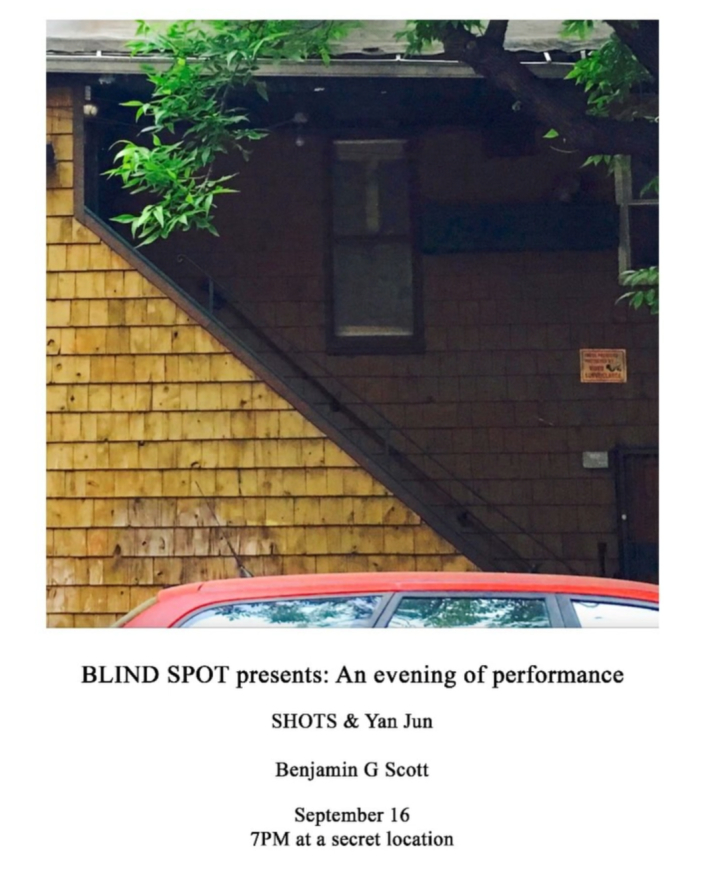
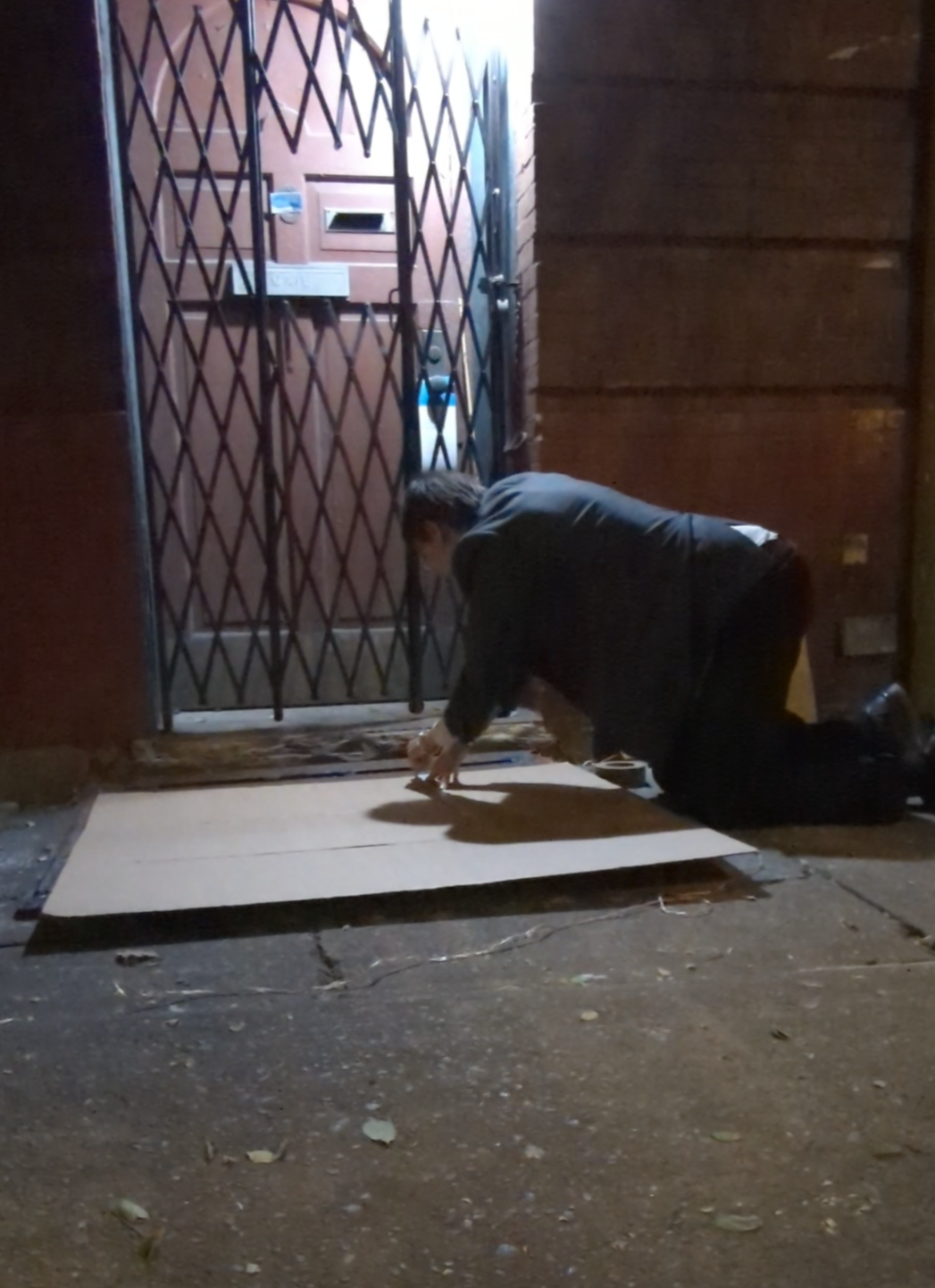 BENJAMIN G. SCOTT knelt over a large cardboard sheet in the middle of the sidewalk with a boxcutter and tape measure, marking and cutting the material into squares at a scrambling yet deliberate pace. Adding an extra layer was the playback via small bluetooth speaker of what was ostensibly the audio of a previous instance of the same action. The two timelines, past and present, unfolded in tandem, sometimes clashing and other times syncing up in a satisfying way. It eventually became clear that the objective was to build a cubic box out of individual panels and packing tape, inside of which Scott placed the speaker before sealing it in. It seems that practice indeed makes perfect, because this time the assembly was completed more quickly; the last few minutes were spent listening to the rest of the recording, slightly muffled from within its new container. Though I do love the raw simplicity of cardboard sounds (Partly Zombish’s August Cake and the Cardboard Sessions tape comes to mind) and the immediacy of manual process, this awkward coda was my favorite part.
BENJAMIN G. SCOTT knelt over a large cardboard sheet in the middle of the sidewalk with a boxcutter and tape measure, marking and cutting the material into squares at a scrambling yet deliberate pace. Adding an extra layer was the playback via small bluetooth speaker of what was ostensibly the audio of a previous instance of the same action. The two timelines, past and present, unfolded in tandem, sometimes clashing and other times syncing up in a satisfying way. It eventually became clear that the objective was to build a cubic box out of individual panels and packing tape, inside of which Scott placed the speaker before sealing it in. It seems that practice indeed makes perfect, because this time the assembly was completed more quickly; the last few minutes were spent listening to the rest of the recording, slightly muffled from within its new container. Though I do love the raw simplicity of cardboard sounds (Partly Zombish’s August Cake and the Cardboard Sessions tape comes to mind) and the immediacy of manual process, this awkward coda was my favorite part.
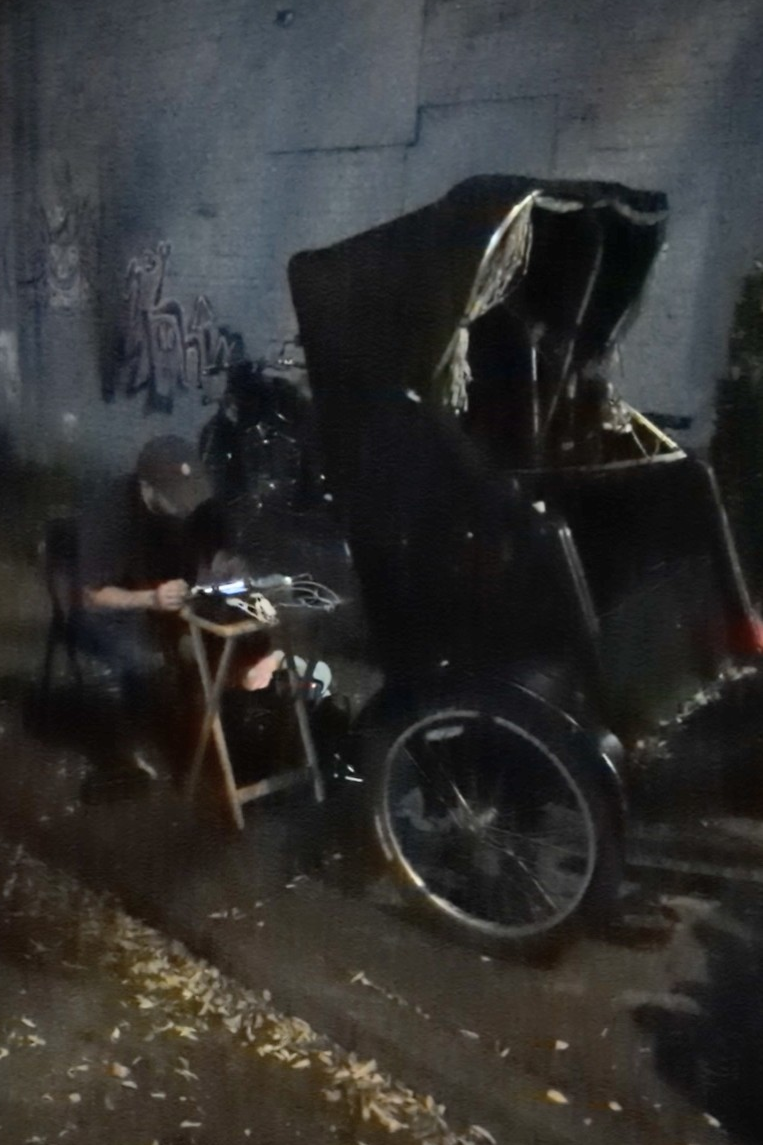 SHOTS were joined by the legendary YAN JUN for the second time, following a set at Providence’s Apartment 13 gallery back in 2023. The pairing is a no-brainer based on their respective bodies of work, and if their first collaboration was proof of concept, the remarkable synergy on display on this cool, cloudy night was a realization of full potential. Daniel DiMaggio and John Friberg, two-thirds of the trio, extended their usual location-spanning setup to every nook and cranny of the block: a small speaker affixed to the awning of the historic Market House remnant at 6 Weehawken squawked out birdsong and emergency sirens, Nakajima-esque gadgets whirred under trees and between parked cars, mystery feedback sliced through the air this way and that. Friberg posted up with a pile of electronics behind a beached carriage bicycle, while DiMaggio was more mobile, at one point rounding the corner onto Christopher to tug at the gate chain of an abandoned storefront.
SHOTS were joined by the legendary YAN JUN for the second time, following a set at Providence’s Apartment 13 gallery back in 2023. The pairing is a no-brainer based on their respective bodies of work, and if their first collaboration was proof of concept, the remarkable synergy on display on this cool, cloudy night was a realization of full potential. Daniel DiMaggio and John Friberg, two-thirds of the trio, extended their usual location-spanning setup to every nook and cranny of the block: a small speaker affixed to the awning of the historic Market House remnant at 6 Weehawken squawked out birdsong and emergency sirens, Nakajima-esque gadgets whirred under trees and between parked cars, mystery feedback sliced through the air this way and that. Friberg posted up with a pile of electronics behind a beached carriage bicycle, while DiMaggio was more mobile, at one point rounding the corner onto Christopher to tug at the gate chain of an abandoned storefront.  Yan was also always on the move, setting up his chair at various places on the opposite end of the street to vocalize and make hand gestures. It was a joy to amble around the haphazard network of miniature events. A highlight was seeing a small crowd crouched around something on the ground and wandering over to reveal an upside-down coffee cup vibrating on a motor—and then it was over, and we were on to the next wonder. The decentralization ensured that no two attendees had the same experience, even though everyone witnessed the same performance. Beyond the superficial similarities of Shots’ and Yan’s approaches, the unifying essence that also served as bedrock for this open-ended meeting is their shared intentionality. No matter how random and/or inscrutable an incident might appear, it was meant to be so. Such purposefulness produces a fascinating energy, an energy that joined disparate parts into a single web of sound, etc. I’ll be thinking about this one for a long time.
Yan was also always on the move, setting up his chair at various places on the opposite end of the street to vocalize and make hand gestures. It was a joy to amble around the haphazard network of miniature events. A highlight was seeing a small crowd crouched around something on the ground and wandering over to reveal an upside-down coffee cup vibrating on a motor—and then it was over, and we were on to the next wonder. The decentralization ensured that no two attendees had the same experience, even though everyone witnessed the same performance. Beyond the superficial similarities of Shots’ and Yan’s approaches, the unifying essence that also served as bedrock for this open-ended meeting is their shared intentionality. No matter how random and/or inscrutable an incident might appear, it was meant to be so. Such purposefulness produces a fascinating energy, an energy that joined disparate parts into a single web of sound, etc. I’ll be thinking about this one for a long time.
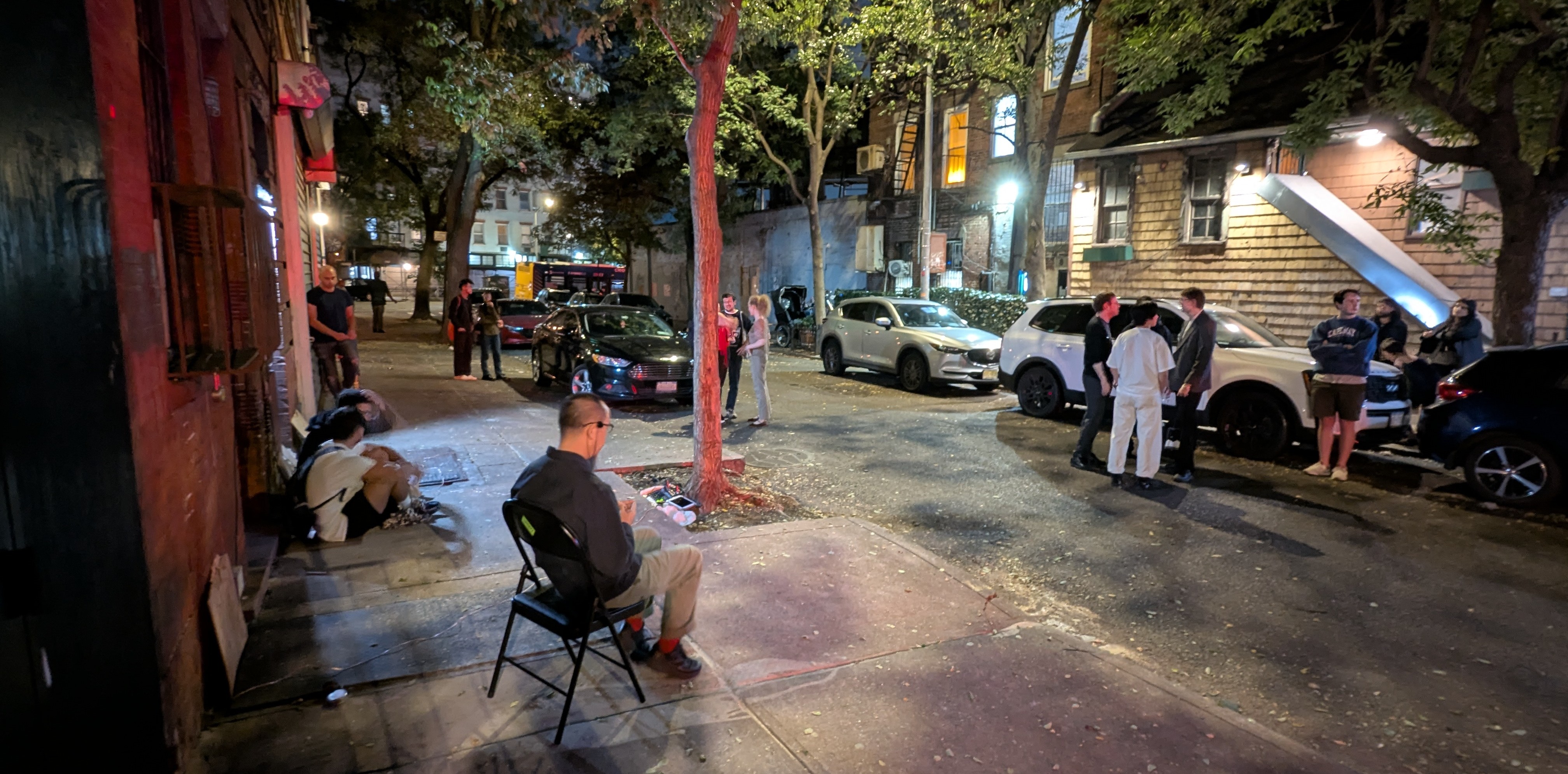
Review: Stalking – Feedback Destroyer (Breaching Static, Aug 29)
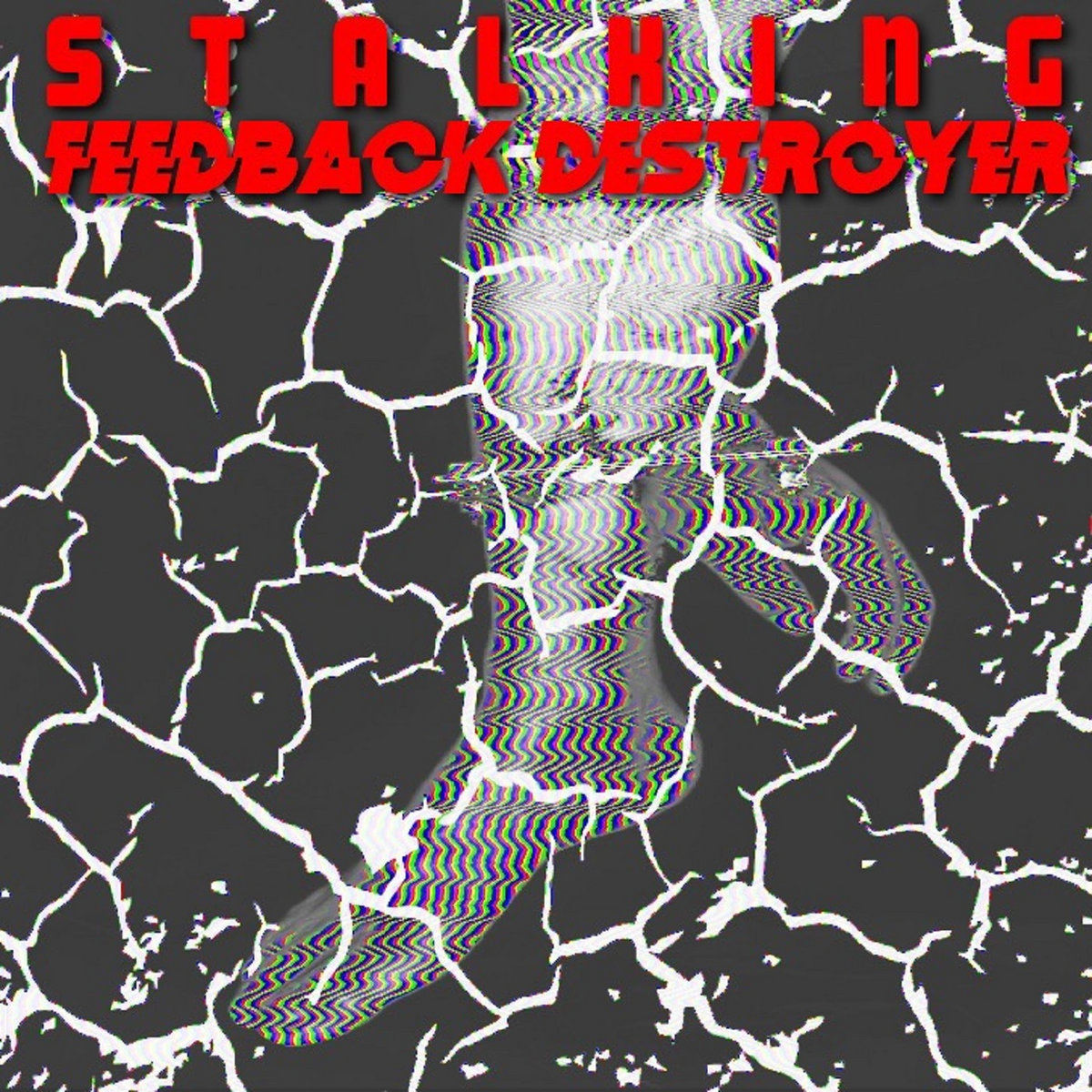 Feedback Destroyer is a misleading title. On his first outing as Stalking, Matt Hex does plenty of gating, chopping, strangling, crushing, warping, all actions that one might call destructive. But feedback is like energy—indestructible. In lieu of being ground into nothing, it escapes to areas of less pressure, contorting into unpredictable and exciting shapes. This is the essence of feedback noise, and it has been for decades; this new CD-R from underappreciated Dubuque imprint Breaching Static doesn’t try to reinvent the wheel. What it does do is carve out ample space in a surging cut-up harsh revival that spans the States and beyond. Stalking is not yet another high-tech modular initiative doomed to stand in the shadows of modern titans Negation or 886VG, nor is it a novel deconstruction of the tradition itself in the vein of Prolepsis or Parasite Nurse. The closest comparison that comes to mind is Developer: no-frills, muscular pedal-chain frenzy that doesn’t waste a single second. At 21 tracks, there’s no shortage of ideas. Other artists might have shelved some of these sketches for future releases, but Hex lays it all out on the table, opting to offer an LP’s worth of material for his first outing. No samples, no silent stretches, no ambient interludes, just noise. The stereo field gets a comprehensive pummeling, the crunch blasting through mono, left, right, and all over, always changing up just as you start to find your footing. The pace is incessant and intense, but Hex isn’t afraid to fuck around a bit now and then either; there’s more than one grin-inducing delay noodle. Solid, satisfying stuff, and a great debut for this project.
Feedback Destroyer is a misleading title. On his first outing as Stalking, Matt Hex does plenty of gating, chopping, strangling, crushing, warping, all actions that one might call destructive. But feedback is like energy—indestructible. In lieu of being ground into nothing, it escapes to areas of less pressure, contorting into unpredictable and exciting shapes. This is the essence of feedback noise, and it has been for decades; this new CD-R from underappreciated Dubuque imprint Breaching Static doesn’t try to reinvent the wheel. What it does do is carve out ample space in a surging cut-up harsh revival that spans the States and beyond. Stalking is not yet another high-tech modular initiative doomed to stand in the shadows of modern titans Negation or 886VG, nor is it a novel deconstruction of the tradition itself in the vein of Prolepsis or Parasite Nurse. The closest comparison that comes to mind is Developer: no-frills, muscular pedal-chain frenzy that doesn’t waste a single second. At 21 tracks, there’s no shortage of ideas. Other artists might have shelved some of these sketches for future releases, but Hex lays it all out on the table, opting to offer an LP’s worth of material for his first outing. No samples, no silent stretches, no ambient interludes, just noise. The stereo field gets a comprehensive pummeling, the crunch blasting through mono, left, right, and all over, always changing up just as you start to find your footing. The pace is incessant and intense, but Hex isn’t afraid to fuck around a bit now and then either; there’s more than one grin-inducing delay noodle. Solid, satisfying stuff, and a great debut for this project.
Copies available via email: breachingstatic@gmail.com.


